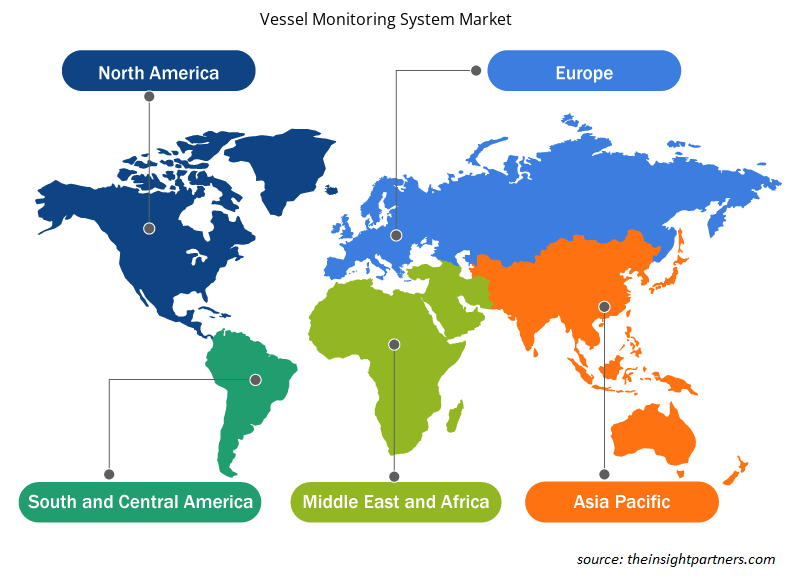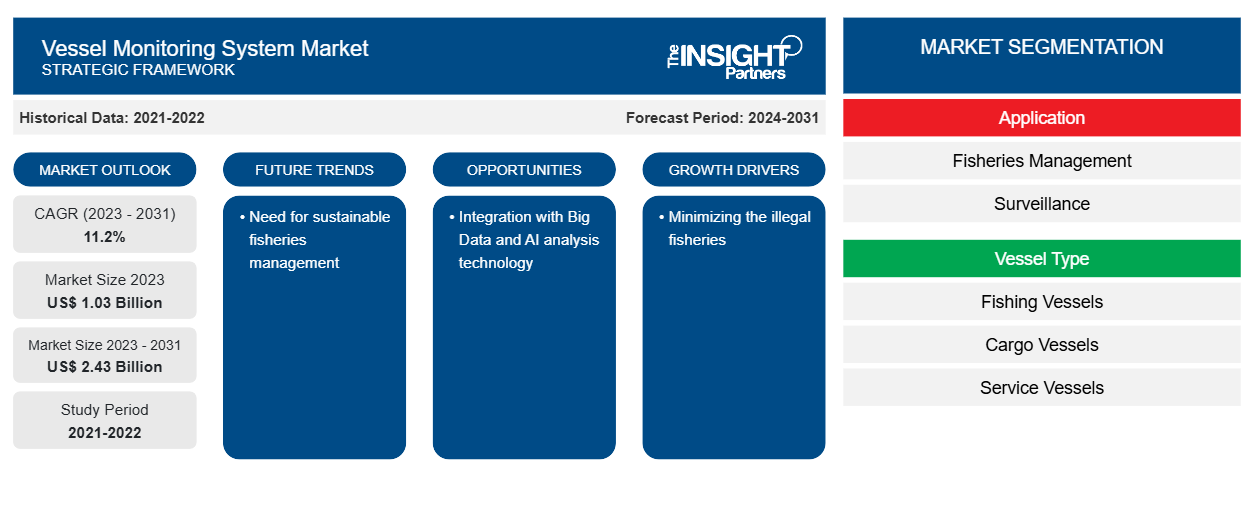船舶監視システムの市場規模は、2023 年の 10 億 3,000 万米ドルから 2031 年には 24 億 3,000 万米ドルに達すると予測されています。市場は 2023 年から 2031 年にかけて 11.2% の CAGR を記録すると予想されています。漁業用途の増加と不正取引防止の必要性は、今後も船舶監視システム市場の主要トレンドであり続けると思われます。
船舶監視システム市場分析
船舶監視システムは、適切な漁法を保証し、違法漁業を防止することで、海洋環境の管理と持続可能性の向上に役立ち、その結果、漁師の生活の保護と向上につながります。船舶監視システムは主に漁業管理に使用されます。船舶監視システムの目的は、VMS を装備した船舶の制限漁場内での動きを監視することです。持続可能な漁業管理への移行により、船舶監視システムの需要が生まれています。
船舶監視システム市場の概要
船舶監視システム (VMS) は、環境および漁業規制機関が漁船の活動を監視および追跡できるようにするために商業漁業で使用されるシステムを表すためによく使用される用語です。これらは、国家レベルおよび国際レベルの監視制御および監視 (MCS) プログラムの重要な部分です。VMS は、国または国の下位区分の領海内の船舶を監視および追跡するためにも使用されます。
要件に合わせてレポートをカスタマイズする
このレポートの一部、国レベルの分析、Excelデータパックなど、あらゆるレポートを無料でカスタマイズできます。また、スタートアップや大学向けのお得なオファーや割引もご利用いただけます。
- このレポートの主要な市場動向を入手してください。この無料サンプルには、市場動向から見積もりや予測に至るまでのデータ分析が含まれます。
船舶監視システム市場の推進要因と機会
市場関係者による違法漁業を最小限に抑え、市場を有利にする
漁業は、世界中の人々にとって、食料、レクリエーション、雇用、貿易、経済的幸福の不可欠な源です。人口の増加と飢餓の継続により、魚は食糧安全保障の達成に不可欠な商品として浮上しています。しかし、違法、無報告、無規制の漁業活動は、漁業の持続可能性を確保するための国際的な取り組みを深刻に脅かしています。2023年6月、国連食糧農業機関(FAO)によると、違法、無報告、無規制の漁業活動により、毎年1,100万~2,600万トンの魚が失われており、その経済的価値は100億~230億米ドルと推定されています。したがって、違法漁業を最小限に抑えるために、船舶監視システムの需要が高まっています。これは、認可された漁船を効果的かつ確実に監視し 、 違法または無許可の船舶を検出するのに役立ちます。
持続可能な漁業管理の必要性 - 船舶監視システム市場における機会
二酸化炭素排出量の26%以上と熱の93%以上が、世界全体で海洋に吸収されています。海洋生態系の変化、海面上昇、病気の発生頻度の増加、海水の酸性化、主要種の死亡率の増加と生産性の低下、多くの重要な魚種の地理的分布の変化により、漁業に依存して健康、幸福、生計を立てている5億人が影響を受けています。さらに、持続不可能な漁業は、漁船からの排出を引き起こし、海洋生態系に損害を与えます。これらはいずれも気候変動の一因となっています。したがって、持続可能な漁業管理を実施する必要があり、それには、当局/組織が漁業活動を持続的に管理および制御するための強力なほぼリアルタイムの洞察を提供するのに役立つ船舶監視システムの需要が生まれます。
船舶監視システム市場レポートのセグメンテーション分析
船舶監視システム市場分析の導出に貢献した主要なセグメントは、アプリケーションと船舶の種類です。
- アプリケーションに基づいて、市場は漁業管理、監視、その他に分類されます。監視セグメントは2023年に大きな市場シェアを占めました。
- 船舶の種類別に見ると、市場は漁船、貨物船、サービス船、客船、フェリー、その他に分類されています。2023年には漁船セグメントが市場で最大のシェアを占めました。
船舶監視システムの地域別市場シェア分析
船舶監視システム市場レポートの地理的範囲は、主に北米、アジア太平洋、ヨーロッパ、中東およびアフリカ、南米/中南米の 5 つの地域に分かれています。
収益面では、アジア太平洋地域が2023年に最大の船舶監視システム市場シェアを占めました。日本、インド、中国、スリランカなどの国々は、アジア太平洋の船舶監視システム市場の主要国です。この地域では、船舶の位置、その他の交通、気象関連の危険を特定する船舶監視を必要とするさまざまな海事プロジェクトに従事しています。また、港や水路の包括的な交通管理も監督しています。たとえば、2023年5月、日本の国立海洋技術研究所は、船舶データセンター(ShipDC)が保存する船上監視データと、日本気象協会(JWA)が提供するPOLARIS海洋データサービスの情報を組み合わせた、新しい船舶データ分析プロジェクトの結果を発表しました。
船舶監視システム市場の地域別分析
予測期間を通じて船舶監視システム市場に影響を与える地域的な傾向と要因は、Insight Partners のアナリストによって徹底的に説明されています。このセクションでは、北米、ヨーロッパ、アジア太平洋、中東およびアフリカ、南米および中米にわたる船舶監視システム市場のセグメントと地理についても説明します。

- 船舶監視システム市場の地域別データを入手
船舶監視システム市場レポートの範囲
| レポート属性 | 詳細 |
|---|---|
| 2023年の市場規模 | 10億3千万米ドル |
| 2031年までの市場規模 | 24億3千万米ドル |
| 世界のCAGR(2023年~2031年) | 11.2% |
| 履歴データ | 2021-2022 |
| 予測期間 | 2024-2031 |
| 対象セグメント | アプリケーション別
|
| 対象地域と国 | 北米
|
| 市場リーダーと主要企業プロフィール |
|
船舶監視システム市場のプレーヤー密度:ビジネスダイナミクスへの影響を理解する
船舶監視システム市場は、消費者の嗜好の変化、技術の進歩、製品の利点に対する認識の高まりなどの要因により、エンドユーザーの需要が高まり、急速に成長しています。需要が高まるにつれて、企業は提供を拡大し、消費者のニーズを満たすために革新し、新たなトレンドを活用し、市場の成長をさらに促進しています。
市場プレーヤー密度とは、特定の市場または業界内で活動している企業または会社の分布を指します。これは、特定の市場スペースに、その市場規模または総市場価値に対してどれだけの競合相手 (市場プレーヤー) が存在するかを示します。
船舶監視システム市場で事業を展開している主要企業は次のとおりです。
- アプライドサテライトテクノロジー株式会社
- アドバリューテクノロジーズ
- 北京ハイランダーデジタルテクノロジー株式会社
- ブルートレーカー
- CLSA
- オーブコム
免責事項:上記の企業は、特定の順序でランク付けされていません。

- 船舶監視システム市場のトップキープレーヤーの概要を入手
船舶監視システム市場のニュースと最近の動向
船舶監視システム市場は、重要な企業出版物、協会データ、データベースを含む一次調査と二次調査後の定性的および定量的データを収集することによって評価されます。以下は、市場の動向の一覧です。
- 2021年3月、モディ首相は「インド海事サミット2021」を発足させ、海事産業を世界トップのベンチマークと同等にすることを目的とした海事ビジョン2030の電子書籍を発表しました。インドは、船員や漁師が困ったときに役立つリアルタイムの船舶追跡システムを導入しました。インド船舶を世界中で追跡できるだけでなく、インドの海岸線から1,000km以内の外国船舶も追跡できます。(出典:ニュース、プレスリリース、2021年)
- 2022年6月21日、国際移住機関(IOM)が実施するスリランカ船舶監視システム(VMS)プロジェクトの一環として、24時間365日体制の漁業監視センター(FMC)が正式に開設されました。スリランカVMSプロジェクトでは、4,200隻の多日漁船(MFV)にVMSトランスポンダーが搭載され、DFARはMFVの動きを効果的に監視し、違法・無報告・無規制(IUU)漁業に関するインド洋まぐろ類委員会(IOTC)の規制に準拠できるようになります。(出典:IOM、プレスリリース、2022年)
船舶監視システム市場レポートの対象範囲と成果物
「船舶監視システム市場規模と予測(2021〜2031年)」レポートでは、以下の分野をカバーする市場の詳細な分析を提供しています。
- 対象範囲に含まれるすべての主要市場セグメントの世界、地域、国レベルでの市場規模と予測
- 市場の動向(推進要因、制約、主要な機会など)
- 今後の主な動向
- 詳細なPEST/ポーターの5つの力とSWOT分析
- 主要な市場動向、主要プレーヤー、規制、最近の市場動向を網羅した世界および地域の市場分析
- 市場集中、ヒートマップ分析、主要プレーヤー、最近の動向を網羅した業界の状況と競争分析
- 詳細な企業プロフィール
- 過去2年間の分析、基準年、CAGRによる予測(7年間)
- PEST分析とSWOT分析
- 市場規模価値/数量 - 世界、地域、国
- 業界と競争環境
- Excel データセット


- Aquaculture Market
- Non-Emergency Medical Transportation Market
- Molecular Diagnostics Market
- Rugged Phones Market
- 3D Audio Market
- Europe Tortilla Market
- Adaptive Traffic Control System Market
- Excimer & Femtosecond Ophthalmic Lasers Market
- Integrated Platform Management System Market
- Biopharmaceutical Tubing Market

Report Coverage
Revenue forecast, Company Analysis, Industry landscape, Growth factors, and Trends

Segment Covered
This text is related
to segments covered.

Regional Scope
North America, Europe, Asia Pacific, Middle East & Africa, South & Central America

Country Scope
This text is related
to country scope.
よくある質問
The global vessel monitoring system market was estimated to be US$ 1.03 billion in 2023 and is expected to grow at a CAGR of 11.2% during the forecast period 2023 - 2031.
Growth in fishing applications and the requirement to prevent unauthorized dealings are the major factors that propel the global vessel monitoring system market.
Integration with Big Data and AI analysis technology is anticipated to play a significant role in the global vessel monitoring system market in the coming years.
The key players holding majority shares in the global vessel monitoring system market are Applied Satellite Technology Ltd., Addvalue Technologies, Beijing Highlander Digital Technology Co., Ltd., BlueTraker, and CLS.
The global vessel monitoring system market is expected to reach US$ 2.43 billion by 2031.
The incremental growth expected to be recorded for the global vessel monitoring system market during the forecast period is US$ 1.39 billion.
Trends and growth analysis reports related to Electronics and Semiconductor : READ MORE..
The Insight Partners performs research in 4 major stages: Data Collection & Secondary Research, Primary Research, Data Analysis and Data Triangulation & Final Review.
- Data Collection and Secondary Research:
As a market research and consulting firm operating from a decade, we have published and advised several client across the globe. First step for any study will start with an assessment of currently available data and insights from existing reports. Further, historical and current market information is collected from Investor Presentations, Annual Reports, SEC Filings, etc., and other information related to company’s performance and market positioning are gathered from Paid Databases (Factiva, Hoovers, and Reuters) and various other publications available in public domain.
Several associations trade associates, technical forums, institutes, societies and organization are accessed to gain technical as well as market related insights through their publications such as research papers, blogs and press releases related to the studies are referred to get cues about the market. Further, white papers, journals, magazines, and other news articles published in last 3 years are scrutinized and analyzed to understand the current market trends.
- Primary Research:
The primarily interview analysis comprise of data obtained from industry participants interview and answers to survey questions gathered by in-house primary team.
For primary research, interviews are conducted with industry experts/CEOs/Marketing Managers/VPs/Subject Matter Experts from both demand and supply side to get a 360-degree view of the market. The primary team conducts several interviews based on the complexity of the markets to understand the various market trends and dynamics which makes research more credible and precise.
A typical research interview fulfils the following functions:
- Provides first-hand information on the market size, market trends, growth trends, competitive landscape, and outlook
- Validates and strengthens in-house secondary research findings
- Develops the analysis team’s expertise and market understanding
Primary research involves email interactions and telephone interviews for each market, category, segment, and sub-segment across geographies. The participants who typically take part in such a process include, but are not limited to:
- Industry participants: VPs, business development managers, market intelligence managers and national sales managers
- Outside experts: Valuation experts, research analysts and key opinion leaders specializing in the electronics and semiconductor industry.
Below is the breakup of our primary respondents by company, designation, and region:

Once we receive the confirmation from primary research sources or primary respondents, we finalize the base year market estimation and forecast the data as per the macroeconomic and microeconomic factors assessed during data collection.
- Data Analysis:
Once data is validated through both secondary as well as primary respondents, we finalize the market estimations by hypothesis formulation and factor analysis at regional and country level.
- Macro-Economic Factor Analysis:
We analyse macroeconomic indicators such the gross domestic product (GDP), increase in the demand for goods and services across industries, technological advancement, regional economic growth, governmental policies, the influence of COVID-19, PEST analysis, and other aspects. This analysis aids in setting benchmarks for various nations/regions and approximating market splits. Additionally, the general trend of the aforementioned components aid in determining the market's development possibilities.
- Country Level Data:
Various factors that are especially aligned to the country are taken into account to determine the market size for a certain area and country, including the presence of vendors, such as headquarters and offices, the country's GDP, demand patterns, and industry growth. To comprehend the market dynamics for the nation, a number of growth variables, inhibitors, application areas, and current market trends are researched. The aforementioned elements aid in determining the country's overall market's growth potential.
- Company Profile:
The “Table of Contents” is formulated by listing and analyzing more than 25 - 30 companies operating in the market ecosystem across geographies. However, we profile only 10 companies as a standard practice in our syndicate reports. These 10 companies comprise leading, emerging, and regional players. Nonetheless, our analysis is not restricted to the 10 listed companies, we also analyze other companies present in the market to develop a holistic view and understand the prevailing trends. The “Company Profiles” section in the report covers key facts, business description, products & services, financial information, SWOT analysis, and key developments. The financial information presented is extracted from the annual reports and official documents of the publicly listed companies. Upon collecting the information for the sections of respective companies, we verify them via various primary sources and then compile the data in respective company profiles. The company level information helps us in deriving the base number as well as in forecasting the market size.
- Developing Base Number:
Aggregation of sales statistics (2020-2022) and macro-economic factor, and other secondary and primary research insights are utilized to arrive at base number and related market shares for 2022. The data gaps are identified in this step and relevant market data is analyzed, collected from paid primary interviews or databases. On finalizing the base year market size, forecasts are developed on the basis of macro-economic, industry and market growth factors and company level analysis.
- Data Triangulation and Final Review:
The market findings and base year market size calculations are validated from supply as well as demand side. Demand side validations are based on macro-economic factor analysis and benchmarks for respective regions and countries. In case of supply side validations, revenues of major companies are estimated (in case not available) based on industry benchmark, approximate number of employees, product portfolio, and primary interviews revenues are gathered. Further revenue from target product/service segment is assessed to avoid overshooting of market statistics. In case of heavy deviations between supply and demand side values, all thes steps are repeated to achieve synchronization.
We follow an iterative model, wherein we share our research findings with Subject Matter Experts (SME’s) and Key Opinion Leaders (KOLs) until consensus view of the market is not formulated – this model negates any drastic deviation in the opinions of experts. Only validated and universally acceptable research findings are quoted in our reports.
We have important check points that we use to validate our research findings – which we call – data triangulation, where we validate the information, we generate from secondary sources with primary interviews and then we re-validate with our internal data bases and Subject matter experts. This comprehensive model enables us to deliver high quality, reliable data in shortest possible time.


 このレポートの無料サンプルを入手する
このレポートの無料サンプルを入手する